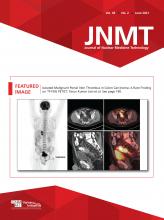As a professional society representing more than 16,000 nuclear medicine professionals, it is our responsibility to ensure the health and safety of our patients and members by distributing recommendations to mitigate the risk of COVID-19 transmission in clinical practice. We understand the often-overlapping symptoms that COVID-19 and pulmonary embolism can present and appreciate the diagnostic importance of the ventilation portion of the ventilation/perfusion (V/Q) scan for patient care.
On March 19, 2020, SNMMI released a statement responding to concerns regarding V/Q lung scans and, specifically, the inherent risk of spread of COVID-19 to patients and staff related to the ventilation portion of the study. At that time, many institutions opted not to perform ventilation studies.
Subsequently, on September 3, 2020, SNMMI released an updated statement noting that since March 2020, the COVID-19 pandemic had evolved differently in various regions of the world and, with increased availability of COVID-19 PCR testing, resumption of ventilation studies could be considered in some scenarios.
Since the time of the revised statement (September 2020), there have been significant developments regarding the COVID-19 pandemic, including but not limited to emergency approval of three vaccines by the FDA, all of which are actively being distributed, and readily available COVID-19 testing for the public. Additionally, further safety measures have been introduced and implemented specific to the performance of V/Q scans.
Considering the above observations, SNMMI has again revised this statement to continue to provide the most up-to-date information to our members. SNMMI believes that ventilation scans can be increasingly incorporated as a routine part of the work-up of suspected pulmonary embolism. SNMMI recognizes that there are variations in practice patterns where the primary reliance is on perfusion-only lung scans, aided as necessary with SPECT or SPECT/CT.
The goal of this updated statement is to recognize that, in many situations, a ventilation study may be thought to be clinically necessary to help diagnose lung disease, including vascular and airway disease. In these settings, performance of ventilation studies may be considered, with local and institutional COVID-19 policies and procedures for aerosol-generating and non-aerosolizing procedures serving as the primary source of guidance.
The following considerations, which typically are included in facility policies and procedures, should be reviewed prior to performing ventilation studies:
1. Consideration should be given to a COVID-19 PCR test, depending on local policies or institutional guidelines.
2. When performing ventilation studies, technologists should wear appropriate personal protective equipment (PPE) in accordance with local policies.
3. Airflow of the room in which the ventilation studies are performed should be evaluated, which may help to determine the required time for room turnover after the performance of a ventilation study.
4. The selection of the appropriate agent for the ventilation study should be carefully considered.
5. Local infection control groups should be engaged for guidance and to help evaluate facilities, equipment, and staff PPE necessary to safely perform ventilation studies.
6. The approach to performing a ventilation scan in relation to the perfusion scan (i.e., ventilation then perfusion vs. perfusion then ventilation) should be considered according to the clinical indication and consultation with the referring physician may be advisable.
As the incidence and the prevalence of COVID-19 have started to decline in many parts of the country, it may now be feasible to resume the use of ventilation scans to improve the diagnostic specificity of lung scans while following institutional safety guidelines. SNMMI will continue to monitor the COVID-19 pandemic and provide updated information whenever possible.
In addition to these considerations, safety updates and enhancements were developed that may assist with specific V/Q study questions. See the full list at https://www.snmmi.org/NewsPublications/NewsDetail.aspx?ItemNumber=36714.
REFERENCES AND SAFETY RECOMMENDATIONS
- 1.
- 2.







